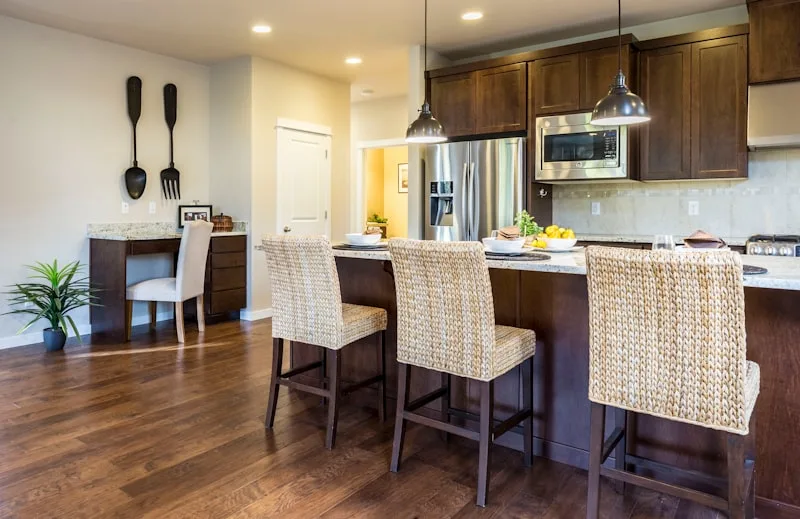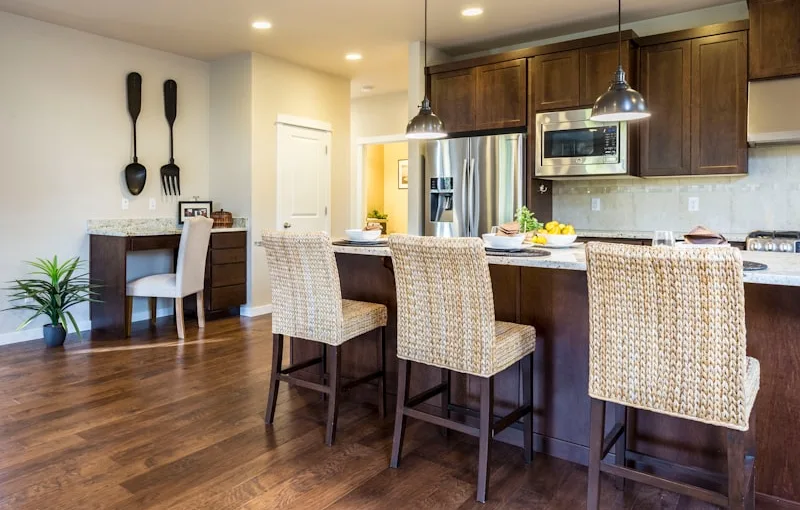
Typically, upper cabinets are installed about 18 to 24 inches above the countertop. This height allows for easy access while still keeping everything within reach. Imagine trying to grab a spice jar from a cabinet that’s too high—it’s like trying to reach the top shelf at the grocery store without a ladder! You want your kitchen to be functional, not a workout session.
But what if you’re on the shorter side or have a towering ceiling? In that case, consider your own height and the height of your countertops. If you’re petite, you might want to lean towards the lower end of that range. On the flip side, if you’re blessed with high ceilings, you can take advantage of that space by installing cabinets closer to the ceiling, creating a stunning visual effect while maximizing storage.
Another thing to think about is the overall design of your kitchen. If you have a modern, open layout, you might want to keep those cabinets a bit higher to maintain a sleek look. It’s like wearing a tailored suit—everything just fits better when it’s proportionate.
Reaching New Heights: The Ultimate Guide to Upper Kitchen Cabinet Placement
First off, think about your ceiling height. If you’ve got soaring ceilings, why not take advantage of that vertical space? Placing your upper cabinets closer to the ceiling not only draws the eye upward, making the room feel larger, but it also gives you extra storage for those items you rarely use. Just picture those holiday platters tucked away, waiting for their moment to shine!
Now, let’s talk about the golden rule of cabinet height. Ideally, the bottom of your upper cabinets should be about 18 inches above your countertop. This sweet spot allows for easy access while keeping everything within reach. But hey, if you’re on the taller side, you might want to raise them a bit higher. It’s all about comfort—after all, you don’t want to be doing the kitchen limbo every time you grab a spice!
And don’t forget about the layout! If your kitchen is an open concept, consider how your upper cabinets will flow with the rest of the space. You want them to complement your design, not clash with it. Think of your cabinets as the icing on the cake; they should enhance the overall look without overwhelming it.
Lastly, lighting plays a crucial role in upper cabinet placement. Installing under-cabinet lighting can create a warm ambiance while making your workspace more functional. It’s like adding a spotlight to your culinary masterpieces! So, as you plan your upper kitchen cabinet placement, keep these tips in mind to truly elevate your kitchen experience.
Cabinet Conundrum: Finding the Perfect Height for Your Kitchen Storage
First off, think about your daily routine. Are you the type who loves to whip up gourmet meals, or do you prefer quick, easy snacks? If you’re constantly reaching for ingredients, you’ll want your most-used items within arm’s reach. A cabinet height of around 18 to 24 inches above the countertop is often ideal for easy access. It’s like having a trusty sidekick right there when you need it!
Now, let’s talk about aesthetics. A kitchen is more than just a workspace; it’s the heart of your home. If your cabinets are too high, they can make the room feel cramped, like wearing a hat that’s two sizes too small. On the flip side, cabinets that are too low can disrupt the flow and make your kitchen feel cluttered. Aim for a height that complements your ceiling and overall design.
And don’t forget about the little ones! If you have kids, consider their reach. You wouldn’t want them to have to scale Mount Everest just to grab a snack. Think about incorporating lower shelves for their favorite treats, making it a win-win for everyone.
Above the Counter: Expert Tips on the Ideal Height for Upper Kitchen Cabinets
First off, the standard height for upper cabinets is typically around 18 inches above the countertop. This sweet spot allows for easy access while keeping everything within reach. But here’s the kicker: everyone’s kitchen is different! If you’re on the taller side, you might want to raise those cabinets a bit higher—think of it as giving your kitchen a little extra breathing room. On the flip side, if you’re more petite, lowering them could save you from a daily game of kitchen gymnastics.
Now, let’s talk about the ceiling. If you’ve got high ceilings, consider extending those cabinets all the way up. Not only does this create a sleek, modern look, but it also maximizes storage. Just picture those beautiful glass-front cabinets showcasing your favorite dishware, all while drawing the eye upward and making your kitchen feel more spacious.
And don’t forget about lighting! Installing under-cabinet lighting can illuminate your workspace beautifully, making cooking a breeze. It’s like having a spotlight on your culinary masterpieces!
So, whether you’re a DIY enthusiast or working with a designer, remember that the height of your upper cabinets should reflect your personal style and functional needs. After all, a kitchen should be as unique as the meals you whip up in it!
The Science of Storage: How Cabinet Height Affects Kitchen Functionality
Think about it: if your cabinets are too high, you might find yourself playing a daily game of “how to reach that.” This can lead to awkward stretching or, worse, a kitchen disaster. On the flip side, cabinets that are too low can cramp your style, making it hard to utilize vertical space effectively. It’s all about finding that sweet spot where convenience meets design.
Now, let’s dive into the nitty-gritty. The standard cabinet height is usually around 30 inches, but this can vary based on your needs. If you’re on the taller side, you might want to consider raising those cabinets a bit higher. This not only gives you more storage but also keeps your countertops clear for all your culinary masterpieces. Conversely, if you’re on the shorter side, lower cabinets can make a world of difference, allowing you to access everything without a step stool.
From Floor to Ceiling: Maximizing Space with the Right Upper Cabinet Height
First off, let’s talk about the basics. Standard upper cabinets are usually set around 18 inches above the countertop. But what if you’re on the taller side or have a unique ceiling height? You don’t want to be reaching for that spice jar on the top shelf like it’s a game of Jenga! Adjusting the height of your cabinets can create a seamless flow, making your kitchen feel more spacious.
Think of your kitchen as a canvas. If you paint too low, the artwork gets lost; if you paint too high, it feels disconnected. The same goes for cabinets. By raising them closer to the ceiling, you not only draw the eye upward, creating an illusion of height, but you also gain valuable storage space. It’s like finding hidden treasure in your own home!
Now, let’s not forget about aesthetics. A well-placed cabinet can serve as a focal point, adding character to your kitchen. Whether you opt for sleek modern designs or rustic charm, the right height can enhance the overall vibe. Plus, if you’re a fan of open shelving, consider how that interacts with your upper cabinets. It’s all about balance!
So, as you plan your kitchen layout, remember: the right upper cabinet height isn’t just about function; it’s about creating a space that feels just right for you. After all, your kitchen should be a place where you feel inspired to whip up your next culinary masterpiece!
Design Dilemma: How High Should Your Upper Kitchen Cabinets Really Be?
First off, let’s talk about the average height. Most upper cabinets sit around 18 inches above the countertop, but that’s just a guideline. Think about your own height and reach. If you’re on the taller side, you might want to raise those cabinets a bit higher to avoid feeling cramped. On the flip side, if you’re more petite, you don’t want to be climbing on a stool just to grab a bowl. It’s all about comfort and accessibility.
Now, consider the ceiling height. If you’ve got lofty ceilings, why not take advantage? Installing cabinets that stretch closer to the ceiling can create a stunning visual effect, making your kitchen feel more spacious. It’s like adding a crown to your kitchen—elevating the whole vibe! Just remember to leave a little breathing room at the top; you don’t want it to feel like the cabinets are suffocating the space.
And let’s not forget about style. If you’re going for a modern look, sleek, high cabinets can give that clean, streamlined appearance. But if you’re leaning towards a cozy, farmhouse feel, lower cabinets with open shelving can add warmth and charm.
So, how high should your upper kitchen cabinets really be? It’s a balancing act of function, style, and personal preference. Take a moment to envision your dream kitchen, and let that guide your decision. After all, it’s your space, and it should feel just right!
Frequently Asked Questions
What is the Standard Height for Upper Kitchen Cabinets?
The standard height for upper kitchen cabinets is typically 54 inches from the floor, allowing for a comfortable reach for most users. This height can vary based on ceiling height and personal preference, but it is designed to optimize storage and accessibility.
Can I Customize the Height of My Kitchen Cabinets?
Yes, kitchen cabinets can be customized to different heights to suit your needs and preferences. This allows for better functionality and aesthetics in your kitchen design. Consult with a professional to explore options that fit your space and style.
Should Upper Cabinets Be Installed Above the Countertop?
Installing upper cabinets above the countertop is essential for maximizing kitchen storage and functionality. This placement allows for easy access to frequently used items while keeping the countertop clear for food preparation and other tasks. Proper height ensures that the cabinets are within reach and do not obstruct sightlines, enhancing the overall kitchen design.
What Factors Influence Upper Cabinet Height?
The height of upper cabinets is influenced by several factors including ceiling height, the height of the users, the intended use of the cabinets, and design preferences. Standard heights typically range from 18 to 24 inches above the countertop, but adjustments may be made for accessibility and aesthetics. Consideration of these factors ensures functionality and comfort in kitchen design.
How Do I Determine the Right Height for My Kitchen Cabinets?
To determine the ideal height for kitchen cabinets, consider the standard counter height of 36 inches, which is typically comfortable for most users. Wall cabinets are usually installed 18 inches above the countertop, but this can vary based on individual preferences and ceiling height. Measure the height of the primary users to ensure accessibility and comfort. Additionally, consider the overall kitchen design and functionality to achieve a balanced look.
